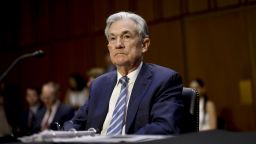Federal Reserve Chairman Jerome Powell was on Capitol Hill Tuesday for the first part of his two-day semiannual monetary policy testimony before Congress.
After Powell delivered remarks about the economy, inflation and the Fed’s actions to date, the head of the US central bank was peppered with questions from Senate Banking Committee members about a variety of topics including jobs and unemployment, household debt, the debt ceiling, geopolitical uncertainty, climate change, and cryptocurrency.
Here are some takeaways from the Senate committee hearing:
A half-point hike is back on the table
When the Fed wrapped up its policy meeting in early February by enacting a quarter-point interest rate hike — the slowest increase after months of jumbo-sized rates — it was all but certain that the moderated pace would repeat at the central bank’s next meeting.
The probability of a quarter-point hike was more than 96% in the days that followed, according to the CME FedWatch Tool.
But in the days and weeks that followed, critical economic data came in scorching hot, from the labor market to consumer spending to some inflation metrics.
In his testimony on Tuesday, Powell said the Fed is prepared to increase the pace of its rate hikes if that continues.
“The latest economic data have come in stronger than expected, which suggests that the ultimate level of interest rates is likely to be higher than previously anticipated,” Powell told lawmakers. “If the totality of the data were to indicate that faster tightening is warranted, we would be prepared to increase the pace of rate hikes.”
Market expectations quickly shifted course: By midday Tuesday, CME FedWatch Tool showed a 67.5% probability of a half-point hike at the March 21-22 meeting.
“Powell hit the market right between the eyes saying if the economy is flying high and moving faster this year, then monetary policy will have to follow with faster and higher rates if they are going to have any chance at bringing inflation down,” Chris Rupkey, chief economist of FwdBonds said in a statement. “The market heard the word faster and that was all they needed to price in a greater chance of a [50 basis point, or half-point] rate hike in two weeks.”
Sen. Warren grills Powell on potential loss of 2 million jobs
Democratic Senator Elizabeth Warren pressed Powell about American job losses being potential casualties of the Fed’s battle against high inflation.
Warren, a frequent critic of the Fed head, noted that an additional 2 million people would have to lose their jobs if the unemployment rate rises from its current 3.4% rate to reach the Fed’s projections of 4.6% by the end of the year.
“If you could speak directly to the two million hardworking people who have decent jobs today, who you’re planning to get fired over the next year, what would you say to them?” Warren asked. “How would you explain your view that they need to lose their jobs?”
Powell argued that all Americans, not just two million, are suffering under high inflation.
“Will working people be better off if we just walk away from our jobs and inflation remains 5% or 6%?” Powell replied.
Powell reiterated that he believes the Fed could bring down inflation without a sharp increase in unemployment, adding that some labor market tightening could occur through reductions of job openings.
Warren countered that the Fed’s track record suggests that modest increases in unemployment would be hard to contain.
“You don’t have a plan to stop a runaway train if that occurs,” Warren said. “Chair Powell, you are gambling with people’s lives.”
Powell calls on Congress to raise the debt ceiling
Powell told lawmakers in no uncertain terms that Congress must raise the US government’s borrowing limit to avoid “extraordinarily adverse” damage to the global economy.
The United States is expected to default on its debt obligations as soon as this summer if Congress doesn’t address the debt ceiling. But Republicans have demanded that any such move be accompanied by steep spending cuts.
“At the end of the day, there’s only one solution to this problem, and that is Congress,” Powell said. “Congress really needs to raise the debt ceiling. That’s the only way out in a timely way that allows us to pay all of our bills.”
Powell added: “I think that the consequences are hard to estimate, but they could be extraordinarily adverse.”
The high-stakes, high-profile debate over the debt ceiling could raise its own risks.
While the effects of the debt ceiling run-up are hard to isolate and quantify, there are some indications that the protracted congressional battle in 2011 contributed to a shake-up in the US economy: Real GDP growth was a weak -0.1% on a quarter-over-quarter annualized basis in the third quarter of 2011. Financial markets were roiled, consumer confidence weakened, the US economic policy uncertainty index set a new high and Standard & Poor’s credit rating agency downgraded the United States to AA+ from AAA.
Key inflation gauge shows little sign of slowing
Inflation has slowed in recent months, measuring 6.4% in January after hitting a 40-year high of 9.1% in June. However, the battle is not yet won, and Powell and other Fed officials have cautioned that disinflation will be bumpy and there’s a long “ways to go.”
Powell on Tuesday said the Fed is seeing some progress on inflation as a result of its nearly yearlong monetary tightening efforts; however, one critical gauge is not budging.
The closely watched index, described as “core services excluding housing” is showing little sign of disinflation, Powell said.
The category accounts for more than half of core consumer expenditures, Powell said.
“To restore price stability, we will need to see lower inflation in this sector, and there will very likely be some softening in labor market conditions,” he said.
The Fed typically focuses on “core” metrics of inflation gauges because they strip out the influences of often volatile categories such as food and energy. Digging in to core services and excluding the (currently lagging) segment of shelter allows the central bank to see more of the direct impact of wage increases.
While goods-producing sectors have a variety of costs to consider, including supply chains and volatile commodity prices, the main expense for service businesses is labor.
Economists have expressed concern about inflation in services-related sectors and the potential for them to remain “sticky,” meaning that once prices go up, they don’t easily go down.
“Although nominal wage gains have slowed somewhat in recent months, they remain above what is consistent with 2% inflation and current trends in productivity,” Powell said Tuesday.
“Strong wage growth is good for workers, but only if it is not eroded by inflation.”
More testimony and plenty more data on deck
Powell will be back before Congress on Wednesday, this time before the House Financial Services Committee.
The Fed chair will deliver his testimony and likely face additional questioning on inflation and what may be in store for the US economy.
Wednesday is the last scheduled public appearance for Powell before the March 22 press conference to cap off the Federal Open Market Committee’s two-day policymaking meeting. In addition to the latest rate hike decision, the Fed will be releasing updated economic projections.
Factoring heavily into the Fed’s decision and projections, however, will be several key economic reports that will be released between now and then.
During the next two weeks, the government will release fresh data on labor turnover, jobless claims, employment growth, consumer and wholesale inflation, and retail sales.
—CNN’s Allison Morrow and Nicole Goodkind contributed to this report.









